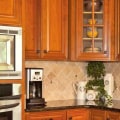Maintaining the aesthetic appeal and longevity of Kirkland kitchen cabinets requires a strategic approach to cleaning, tailored to the specific materials involved. Understanding the nuances of various cabinet finishes can significantly influence the choice of cleaning solutions, whether for natural methods or commercial products. A well-structured cleaning routine not only enhances visual appeal but also protects the integrity of the cabinets over time. However, the effectiveness of these methods may vary, prompting a closer examination of the best practices and products that yield optimal results. What are the critical factors to consider in this transformative process?
Understanding Cabinet Materials
Regarding kitchen cabinets, understanding the various materials is crucial for effective cleaning and maintenance. The choice of material affects your kitchen's aesthetic appeal and influences your cabinets' durability and longevity. Common materials include wood, laminate, metal, and MDF (medium-density fiberboard), each with distinct characteristics.
Wood cabinets, often favored for their natural beauty, come in various species such as oak, cherry, and maple. Their cabinet finishes can range from stains to paints, allowing for customization. However, wood requires careful maintenance to prevent warping and damage from moisture.
Laminate cabinets are a popular choice for their affordability and ease of cleaning. They are made from a composite material covered with a layer of plastic, offering resistance to stains and scratches. Their durability makes them ideal for busy kitchens, but they may lack the warmth of solid wood.
Metal cabinets, typically stainless steel, provide a modern aesthetic and are highly durable. They are resistant to heat and moisture, making them perfect for professional kitchens. However, they can be fingerprints prone and require more frequent cleaning.
MDF is engineered from wood fibers and offers a smooth surface for painting. While it can mimic the appearance of solid wood, its material durability is lower, as it can swell when exposed to water. Understanding these materials and their respective cabinet finishes is essential for selecting the right cabinets and ensuring they remain in excellent condition over time.
Basic Cleaning Supplies Needed
A few essential cleaning supplies can significantly enhance the effectiveness of your kitchen cabinet maintenance routine. To ensure optimal results, it is crucial to gather the right cleaning tools that will help maintain both the appearance and longevity of your cabinets.
Start with a microfiber cloth, which is excellent for trapping dust and grime without scratching surfaces. Pair this with a gentle all-purpose cleaner suitable for the specific material of your cabinets, whether wood, laminate, or another finish. Consider a soft-bristle brush to reach into grooves and hard-to-access areas for deeper cleaning tasks, ensuring thoroughness in your cleaning efforts.
Additionally, having a bucket or spray bottle is essential for diluting cleaning solutions or creating your cleaning mix. A sponge or non-abrasive scrub pad can help tackle stubborn stains without damaging the cabinet surface. For cabinet organization, investing in a caddy or tote to keep your cleaning supplies organized and easily accessible can streamline the cleaning process.
Finally, don't forget about protection. A quality wood polish or conditioner can enhance the wooden cabinets' finish, providing a clean shine and protection against wear and tear. Equipping yourself with these basic cleaning supplies will simplify your cabinet cleaning routine and ensure that your kitchen remains a shining example of cleanliness and organization.
Natural Cleaning Solutions
For those seeking non-toxic alternatives for kitchen cabinet cleaning, natural cleaning solutions offer an effective and environmentally friendly option. A vinegar solution is one of the most popular choices, known for its ability to cut through grease and grime. Mix equal parts of distilled white vinegar and water in a spray bottle to create a simple yet powerful cleaning agent. This solution not only cleans but also disinfects surfaces, making it suitable for the kitchen environment.
When using a vinegar solution, spray it onto the cabinet surfaces and allow it to sit for a few minutes before wiping it down with a soft cloth. This allows the acetic acid in the vinegar to penetrate the dirt, ensuring a thorough cleaning. Baking soda can enhance its cleaning power for tougher stains or sticky residues. Create a paste by combining baking soda with a small amount of water, then apply it to the problem areas. The mild abrasiveness of baking soda helps lift stubborn grime without scratching the cabinet's finish.
Both vinegar and baking soda are readily available, cost-effective, and safe for households with children and pets. By opting for these natural cleaning solutions, homeowners can maintain their kitchen cabinets' pristine condition while adhering to eco-friendly practices. Embracing natural cleaning promotes a healthier living space and contributes to sustainability.
Store-Bought Cleaning Products
Store-bought cleaning products provide a convenient and efficient solution for maintaining kitchen cabinets. These commercially available cleaners come in various formulations designed to tackle specific types of grime, including grease, fingerprints, and food stains. With the fast pace of modern life, many homeowners appreciate the ease of grabbing a bottle off the shelf, especially those designed for quick and effective application.
One essential factor to consider when selecting store-bought products is their product effectiveness. Many brands boast powerful cleaning agents that can cut through tough residues without extensive scrubbing. However, reading labels and choosing safe products for your cabinet materials is crucial to avoid damage.
In recent years, there has been a growing demand for eco-friendly options. These products, often free from harsh chemicals and toxins, offer a sustainable alternative for those looking to protect their health and the environment. Eco-friendly cleaners can be just as effective as traditional products, providing peace of mind while ensuring your kitchen remains safe for food preparation.
When selecting a store-bought cleaning product, consider your specific home cleaning cost needs, the cabinet materials, and any eco-friendly preferences. Balancing product effectiveness with environmental responsibility can lead to a cleaner kitchen and a healthier home. Ultimately, the right store-bought solution can streamline your cleaning routine while ensuring your kitchen cabinets maintain shine and integrity.
Step-By-Step Cleaning Process
Choosing the right cleaning product is only the first step in maintaining the appearance and longevity of kitchen cabinets. To ensure thorough cleaning, follow this step-by-step process incorporating effective cleaning techniques while considering cabinet organization.
Begin by clearing the countertops and removing items from the cabinets. This not only provides a clear workspace but also allows for a comprehensive cleaning of the cabinet surfaces. Next, dust the cabinet exteriors using a microfiber cloth to capture any loose particles.
For deeper cleaning, prepare a solution based on the chosen cleaning product, such as a diluted vinegar solution or a commercial cleaner. Applying the solution to the cabinet surfaces using a soft cloth or sponge, focusing on areas with visible grime or grease. Work in small sections to maintain control and ensure thorough coverage.
Once the surfaces are cleaned, rinse the cloth or sponge in clean water and wipe away any residue from the cleaning solution. This step is crucial to prevent any buildup of cleaning agents that could dull the cabinet finish.
After cleaning, dry the cabinets with a fresh cloth to avoid water damage. Finally, take this opportunity to organize the contents of your cabinets. Arrange items by frequency of use and category to optimize accessibility and maintain a tidy appearance. This systematic approach enhances the look of your kitchen and promotes an efficient cabinet organization.
Preventive Maintenance Tips
While regular cleaning is essential, implementing preventive maintenance tips can significantly extend the life and appearance of your kitchen cabinets. A well-organized cabinet enhances functionality and makes it easier to maintain cleanliness. Ensure optimal cabinet organization; invest in dividers and bins to keep items neatly arranged. This minimizes clutter and reduces the chances of spills or damage over time.
Adjusting your cleaning frequency is another crucial aspect of preventive maintenance. Establish a routine cleaning schedule instead of waiting for visible dirt or grime to accumulate. A light cleaning once a week, using a damp cloth and mild soap, can prevent buildup and keep your cabinets looking fresh. Additionally, avoid using harsh chemicals that can damage the finish; opt for gentle solutions instead.
Humidity control within the kitchen is also vital. High humidity can warp wood cabinets or lead to the growth of mold and mildew. Ensure proper ventilation by using exhaust fans while cooking and keeping windows open when possible.
Regularly inspecting your cabinets for signs of wear, such as loose hinges or chipped finishes, allows for timely repairs, preventing minor issues from escalating into significant problems. Lastly, consider applying a protective finish or sealant periodically to maintain the surface integrity of your cabinets. By following these preventive maintenance tips, you can preserve the beauty and functionality of your kitchen cabinets for years to come.
When To Seek Professional Help
How can you determine when the maintenance of your kitchen cabinets surpasses your DIY capabilities? Homeowners often begin cleaning and restoring their kitchen cabinets, but there comes a time when the task requires professional intervention. Understanding when to DIY and when to seek professionals is crucial for maintaining the integrity and appearance of your cabinetry.
Several signs indicate it may be time to call the experts. First, if you notice extensive damage such as deep scratches, warping, or peeling, these issues usually require specialized repair techniques beyond standard cleaning. Additionally, persistent stains or grime that resist your cleaning efforts may signal a need for professional-grade cleaning solutions and equipment.
Another sign for professionals is if your cabinets are made from high-end materials or intricate finishes that require specific care. DIY solutions can sometimes inadvertently damage these surfaces, leading to costly repairs. Lastly, if your cabinets have been neglected for an extended period, the grease and dirt buildup may be overwhelming, making professional deep-cleaning essential. If you are looking for home cleaning in Kirkland, Puget Sound Cleaners is a perfect choice. Contact them today to get started.
Contact A Trusted Cleaning Solution Service In Kirkland
Keeping your Kirkland kitchen cabinets spotless doesn’t have to be challenging. With the right cleaning solutions and maintenance routine, you can preserve their beauty and extend their lifespan. Whether you’re tackling grease buildup, stubborn stains, or everyday dust, these effective cleaning methods will keep your cabinets looking their best.
Contact Puget Sound Cleaners today and give your kitchen the deep clean it deserves.


